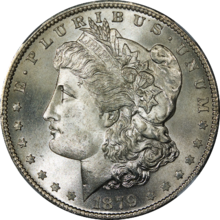Huguenot-Walloon half dollar
A commission run by the Federal Council of Churches in America sought issuance of a half dollar to mark the anniversary, and the bill passed through Congress without opposition in 1923 and was signed by President Warren G. Harding.
Sketches were prepared by commission chairman Reverend John Baer Stoudt and converted to plaster models by the Mint's aging chief engraver, George T. Morgan.
The models were initially rejected by the Commission of Fine Arts, which required revisions under the supervision of Buffalo nickel designer James Earle Fraser.
The choice of William the Silent and Gaspard de Coligny to appear on the obverse was also questioned as the men are considered martyrs by the Huguenots and died decades before the voyage of the Nieuw Nederlandt.
In 1626, Peter Minuit, the Director General for the Dutch West India Company, famously purchased the island of Manhattan from the Native Americans for goods worth some 60 guilders, often rendered as $24.
[8] Vestal stated that he could not support the bill as introduced because it did not designate who should order the coins, but Gernerd indicated that the Fifth National Bank of New York had agreed to act in that capacity.
Stoudt appeared before the committee, explaining that his commission planned a design with the arrival of the Nieuw Nederlandt for one side, and for the other, Peter Minuit purchasing Manhattan from the Native Americans.
Texas Congressman Thomas L. Blanton asked several questions about the bank's interest, but subsided once he was told that it would receive no compensation and that President Harding was connected with the commission.
Rather than seeking a private designer to produce plaster models, the Huguenot-Walloon commission approached the Mint's chief engraver, George T. Morgan, who turned 78 in 1923.
[16][17] Morgan's models were transmitted on October 26, 1923, to the Commission of Fine Arts,[18] charged with rendering advisory opinions on coins by a 1921 executive order by President Harding.
Numismatists Anthony Swiatek and Walter Breen noted, "[This] must have been doubly and trebly humiliating in that Fraser's initial was then adorning the current 5¢ nickel, while neither Barber's nor Morgan's was on any regular issue coinage then in production".
[23] The March 29, 1924, edition of the Jesuit journal America contained an article by F. J. Zwierlein, who stated that the new coin "is more Protestant than the descriptions in the newspaper dispatches led us to believe".
[25] The president of the Huguenot Society of North Carolina responded in a letter to the editor of The New York Times, "that Coligny and William the Silent were 'martyrs in the fight for religious liberty' let the truth of history attest".
[28] Vermeule stated that the Huguenot-Walloon half dollar showed "that the die-engravers trained in and around the Mint did have the ability to combine clear-cut designs with considerable detail.
"[29] A total of 142,080 Huguenot-Walloon half dollars were struck at the Philadelphia Mint in February and April 1924, with 80 of those pieces retained for inspection and testing by the 1925 Assay Commission.
The Huguenot-Walloon commission, to boost sales, engaged as distributor the man they considered to be the most prominent numismatist in the country, Moritz Wormser, president of the American Numismatic Association (ANA).
[33] This in 1925 made politically infeasible the attempts of Minnesota Representative Ole Juulson Kvale, a Lutheran pastor, to obtain a coin for the Norse-American Centennial; he instead settled for a congressionally authorized medal.
[21] The edition of R. S. Yeoman's A Guide Book of United States Coins published in 2018 lists the half dollar at between $125 and $650 depending on condition; a near-pristine specimen sold for $15,275 in 2015.




